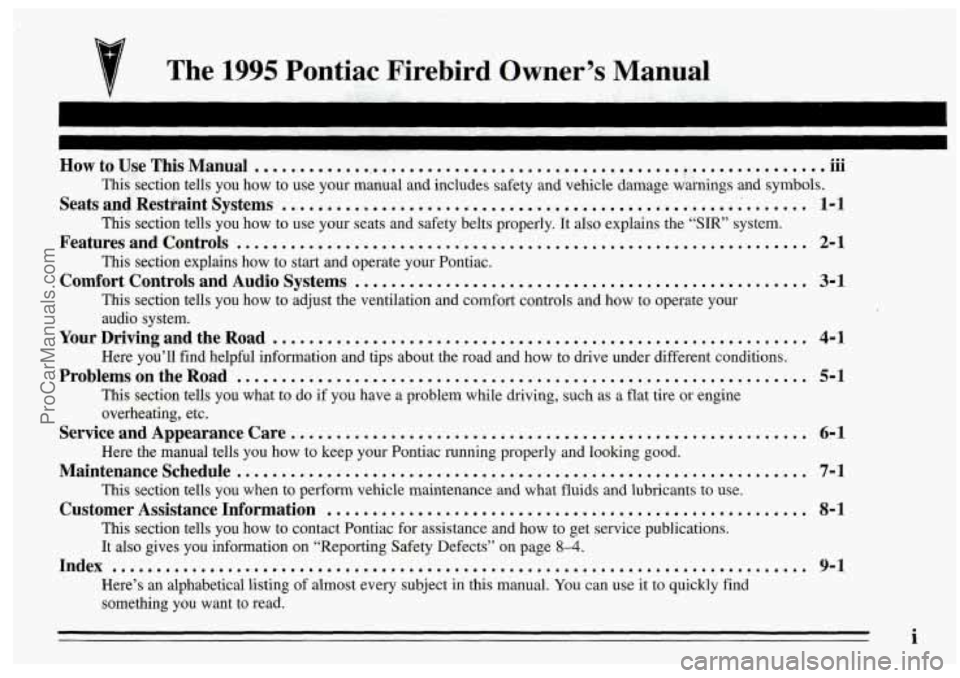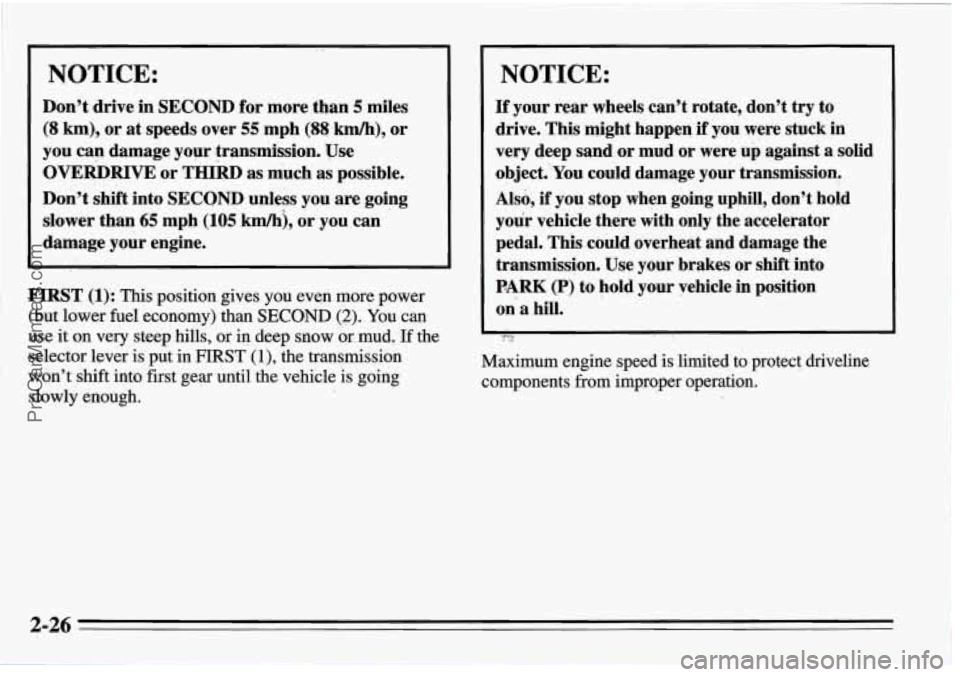engine overheat PONTIAC FIREBIRD 1995 Owners Manual
[x] Cancel search | Manufacturer: PONTIAC, Model Year: 1995, Model line: FIREBIRD, Model: PONTIAC FIREBIRD 1995Pages: 386, PDF Size: 19.66 MB
Page 2 of 386

The 1995 Pontiac Firebird Owner’s Manual
... How to Use This Manual .............................................................. .m
Seats and Restraint Systems .................................................. .’ ....... 1-1
Features and Controls ............................................................... 2-1
Comfort Controls and Audio Systems .................................................. 3-1
This section tells you how to use your manual and includes safety and vehicle damage warnings\
and symbols.
This section tells
you how to use your seats and safety belts properly. It also explains the “SIR’ system.
This section explains how to start and operate your Pontiac.
This section tells you how to adjust the ventilation and comfo\
rt controls and how to operate your
audio system.
Here you’ll find helpful information and tips about the road\
and how to drive under different conditions.
This section tells you what to do if you have a problem whil\
e driving, such as a flat tire or engine
overheating, etc.
Here the manual tells you how to keep your Pontiac running properly and looking good.
This section tells you when to perform vehicle maintenance and what \
fluids and lubricants to use.
This section tells
you how to contact Pontiac for assistance and how to get service publications.
It also gives you information on “Reporting Safety Defects”\
on page 8-4.
Here’s an alphabetical listing of almost every subject in this manual. You can use it to quickly find
something you want to read.
Your Driving and the Road ........................................................... 4-1
ProblemsontheRoad ............................................................... 5-1
Service and Appearance Care ......................................................... 6-1
Maintenanceschedule ............................................................... 7-1
Customer Assistance Information
..................................................... 8-1
Index ........................................................................\
..... 9-1
i
ProCarManuals.com
Page 73 of 386

NOTICE:
Don’t drive in SECOND for more than 5 miles
(8 km), or at speeds over 55 mph (88 km/h), or
you can damage your transmission. Use
OVERDRIVE or
THIRD as much as possible.
Don’t shift into SECOND unless you are going
slower than
65 mph (105 km/h), or you can
damage’your engine.
FIRST (1): This position gives you even more power
(but lower fuel economy) than
SECOND (2). You can
use it
on very steep hills, or in deep snow or. mud. If the
selector lever is put
in FIRST (l), the transmission
won’t shift into
first gear until the vehicle is going
slowly enough.
NOTICE:
If your rear wheels can’t rotate, don’t try to
drive.
This might happen if you were stuck in
very deep sand
or mud or were up against a solid
object.’
You could damage your transmission.
Also, if you stop when going uphill, don’t hold
your vehicle there with only the acceleratw
pedal.
This could overheat and damage the
transmission.
Use your brakes or shift into
BARK (P) to hold your vehicle in position
on.‘
a hill.
.- e 1Y .,
Maximum engine speed is limited to protect driveline
Lomponents from improper operation.
2-26
ProCarManuals.com
Page 119 of 386

Low Traction Light Engine Coolant Temperature Gage
LOW
TRAC
When your anti-lock system is adjusting brake pressure to
help avoid a braking skid, the
LOW TRAC light will
appear
on your instrument cluster. If you have the traction
control system,
this light will also come on when the
system is limiting wheel spin. Slippery road conditions
may
exist if this light comes on, so adjust your driving
accordingly. The light will stay on for a few seconds after
the
anti-lock system stops adjusting brake pressure or the
traction control system stops limiting wheel spin.
This gage shows the engine coolant temperature. If the
gage pointer moves into the red area, your engine is too
hot! It means that your engine coolant has overheated. If
you have been operating your vehicle under normal
driving conditions, you should pull
off the road, stop
your vehicle and turn
off the engine as soon as possible.
In “Problems on the Road,”this manual shows what to
do. See “Engine Overheating” in the Index.
The LOW TRAC light also comes on briefly, as a bulb
check, when the engine is started.
If the light doesn’t
come
on then, have it fixed so it will be there to tell you
when the anti-lock brake system or traction control
system
is active.
2-72
ProCarManuals.com
Page 120 of 386

Low Coolant Light (V8 Engine)
COOLANT
I I
I NOTICE:
Driving with the LOW COOLANT light on caul4
cause your Pontiac to overheat. See “Engine Overheating” in the Index. Your Pontiac&ul@ be
damaged and it wouldn’t be covered
by your
warranty.
This red warning light should come on while you are
starting your engine.
If the light doesn’t come on, have it
repaired. The light also comes
on when the coolant in
your radiator
is low. You may need to add coolant. See
“Engine Coolant” in the Index.
. 2773
ProCarManuals.com
Page 188 of 386

Turn Signals When Towing a Trailer
When you tow a trailer, your vehicle has to have a
different turn signal flasher and extra wiring. The green
arrows on your instrument panel will flash whenever
you signal a turn or lane change. Properly hooked up,
the trailer lamps will also flash, telling other drivers
you’re about to turn, change lanes or stop.
When towing a trailer, the green arrows on your
instrument panel will flash for turns even if the bulbs on
the trailer are burned out. Thus, you may think drivers
behind you are seeing your signal when they are not. It’s
important to check occasionally to be sure the trailer
bulbs are still working.
Driving On Grades
Reduce speed and shift to a lower gear before you start
down a long or steep downgrade.
If you don’t shift
down, you might have to use your brakes
so much that
they would get hot and no longer work well.
On a long uphill grade, shift down and reduce your
speed to around
45 mph (70 km/h) to reduce the
possibility of engine and transmission overheating.
If you are towing a trailer and you have an automatic
transmission with Overdrive, you may prefer
to driving
in THIRD
(D) instead of OVERDRIVE (or, as you need
to, a lower gear). Or, if you have
a manual transmission
with FIFTH (or SIXTH) gear and you are towing a
trailer, it’s better not to use FIFTH (or
SIXTH) gear.
Just drive in FOURTH (drive in FIFTH if you have a
six-speed manual transmission) or, as you need to, a
lower gear.
4-37
ProCarManuals.com
Page 205 of 386

Engine Overheating
You will find a coolant temperature gage on your
Pontiac’s instrument panel. You may also find
a low
coolant warning light on your Pontiac instrument panel.
If Steam Is Coming From Your Engine
NOTICE:
If your engine catches fire because you keep
driving with
no coolant, your vehicle can be
badly damaged. The costly repairs would not be covered by your warranty.
5-16
ProCarManuals.com
Page 206 of 386

~ ~. ~~~ .
If No Steam Is Coming From Your Engine
If you
get the overheat warning but see or hear no
steam, the problem may not be too serious. Sometimes
the engine can get a little too hot when you:
Climb a long hill on a hot day.
Stop after high speed driving.
Idle for long periods in traffic.
Tow a trailer.
If you get the overheat warning with no sign of steam,
try this for a minute or so:
1.
2.
3.
If you have an air conditioner, turn it off.
Turn on your heater to full hot at the highest fan
speed and open the window as necessary.
If you're in a traffic jam, shift to NEUTRAL (N);
otherwise, shift to the highest gear while
driving
-- AUTOMATIC OVERDRIVE (03)
or DRIVE (D) for automatic transmissions.
If you no longer have the overheat warning, you can
drive. Just to be safe, drive slower for about ten minutes.
If the warning doesn't come-back on, you
can drive
normally.
If the warning continues, pull over, stop, and park your
vehicle right away.
If there's still no sign of steam, you can idle the engine
for
two or three minutes while you're parked, to see if
the warning stops. But then, if you still have the
warning,
turn oflthe engine and get everyone out of the
vehide
until it cools down.
You may decide not to lift the hood but to get 'service
help right away.
5-17
ProCarManuals.com
Page 209 of 386

r
NOTICE:
Engine damage from running your engine without coolant isn’t covered by your warranty.
If there seems to be no leak, check to see if the electric
engine fans are running.
If the engine is overheating,
both fans should be running.
If they aren’t, your vehicle
needs service.
How to Add Coolant to the Coolant
Recovery Tank
If you haven’t found a problem yet, but the coolant level
isn’t at
FWLL COLD, add a 50/50 mixture of clean
water (preferably distilled) and a proper antifreeze at the
coolant recovery tank. (See “Engine Coolant”
in the
Index for more information about the proper coolant
mix.)
ProCarManuals.com
Page 210 of 386

NOTICE:
In cold weather, water can freeze and crack the
engine, radiator, heater core and other parts. Use the recommended coolant.
I I
engine parts. Coolant contains ethylene gly
and it will burn if the engine narts arp hnt
When the coolant in the coolant recovery tank is at
WLL COLD, start your vehicle.
If the overheat warning continues, there’s one more
thing you can
try. You can add the proper coolant mix
directly to the radiator, but be sure the cooling system is 1
cool before you do it.
5-21
ProCarManuals.com
Page 215 of 386

How to Add Coolant to the Radiator - LTl
(Code P) Engine Only
NOTICE:
The LTl Engine (Code P) has a specific radiator
fill procedure. Failure to follow this procedure
could cause your engine to overheat and be
severely damaged.
8. Then replace the pressure cap. At any time during
this procedure
if coolant begins to flow out of the
filler neck, reinstall the pressure cap. Be sure the
arrows on the pressure cap line up like this.
5-26
ProCarManuals.com